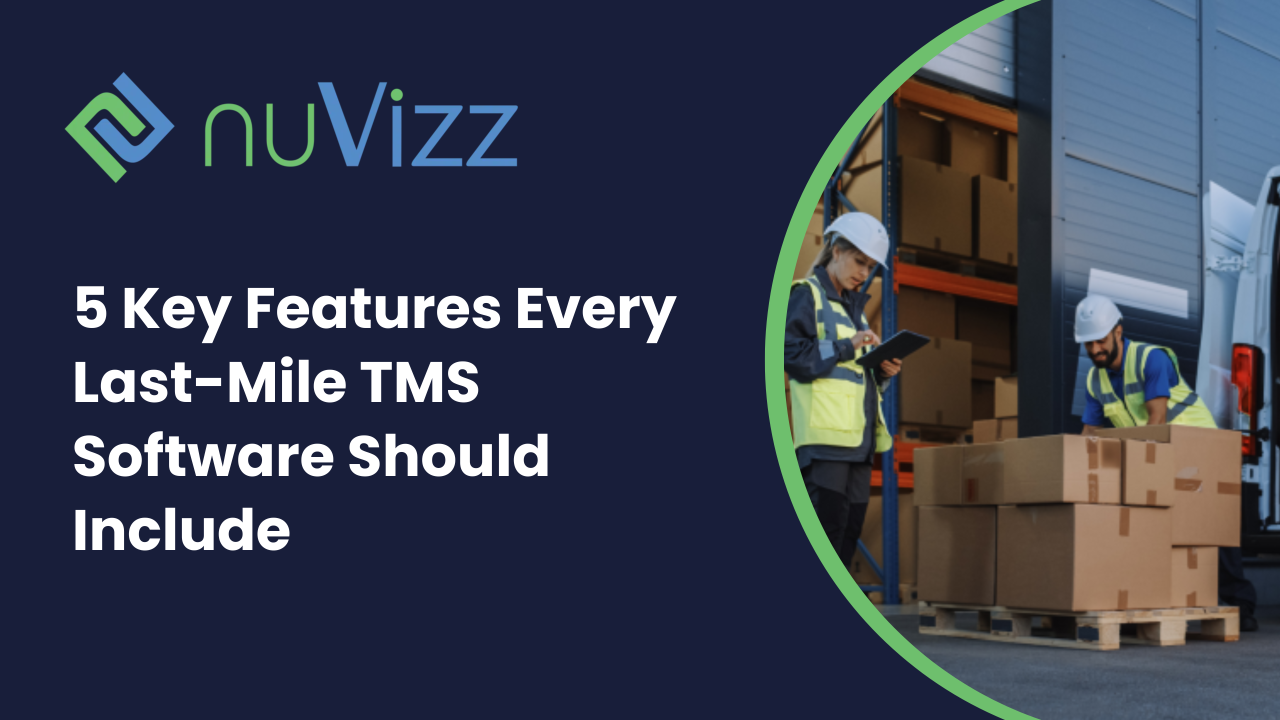Order Capture & Integration capabilities

In today's fast-paced, customer-centric market, maintaining a competitive edge requires the seamless integration of various digital platforms. This is where Application Programming Interfaces (APIs) play a crucial role, especially in the realm of Transportation Management Systems (TMS). APIs enable seamless communication between TMS and various digital platforms, facilitating real-time data exchange, enhancing route planning, and improving delivery efficiency.

Why APIs?
Traditionally, many businesses have used Electronic Data Interchange (EDI) to facilitate data exchange between different systems, standardizing data formats and automating processes. However, EDI has significant limitations, including slower batch processing, lack of flexibility, and the inability to provide real-time updates. In contrast, Application Programming Interfaces (APIs) offer a substantial improvement by enabling instantaneous data exchange, which is crucial for real-time decision-making and operational efficiency. APIs provide greater flexibility and scalability, allowing businesses to adapt to changing requirements and expand their operations without significant reconfiguration. Unlike EDI, APIs can deliver real-time data updates, essential for dynamic adjustments and visibility into ongoing operations. Moreover, APIs enhance customer experience by ensuring seamless communication and timely notifications. The transition from EDI to API is necessary for businesses
to stay competitive and responsive in a rapidly evolving market.
The necessity of transitioning from EDI to API is underscored by the need for businesses to stay competitive and responsive in a rapidly evolving market.

Streamlining Order Entry for Point-to-Point and Multi-Leg Deliveries
Another critical aspect of API integration is the streamlined handling of order entry information. APIs can facilitate the efficient input and management of orders for both point-to-point and multi-leg deliveries.
For point-to-point deliveries, APIs ensure that order details are accurately captured and communicated to all relevant parties. This includes details such as pickup and drop-off locations, delivery time windows, and any special handling instructions. Real-time data exchange through APIs ensures that any changes to the order or delivery instructions are instantly updated, minimizing errors and delays.
For multi-leg deliveries, APIs play an even more significant role. Multi-leg deliveries involve multiple stops and transfers, which can complicate logistics. APIs help manage this complexity by providing a centralized system for order entry and tracking. They enable seamless coordination between different legs of the journey, ensuring that each segment is efficiently planned and executed. This includes optimizing routes for each leg, coordinating transfers, and updating delivery statuses in real-time.

Facilitating Real-Time Data Exchange
APIs act as a bridge, allowing different software systems to communicate and share data effortlessly. In the context of TMS, APIs enable real-time data exchange between transportation management systems and other digital platforms. This real-time data exchange is pivotal for making informed decisions and ensuring efficient operations. For instance, APIs can integrate with GPS systems to provide real-time location data, which is essential for tracking the movement of goods and vehicles.

Enabling Dynamic Updates and Adjustments
APIs allow for dynamic updates and adjustments based on real-time conditions. For example, if there is an unexpected road closure or severe weather conditions, the API can immediately update the route and provide an alternative path. This flexibility is crucial for ensuring timely deliveries and maintaining the reliability of the transportation network.

Enhancing Customer Experience and Satisfaction
In today’s competitive market, customer experience is paramount. API integrations play a vital role in providing customers with accurate delivery information and notifications. Through APIs, customers can receive real-time updates on their delivery status, estimated arrival times, and any changes in the delivery schedule. This transparency and communication enhance customer satisfaction and build trust.

Maintaining Competitiveness in the Market
The integration of APIs is essential for maintaining competitiveness in a fast-paced, customer-centric market. Last-Mile delivery, often the most critical touchpoint in the delivery process, can significantly impact customer perception. Efficient API integration ensures that companies can meet customer expectations, provide timely deliveries, and handle last-minute changes seamlessly.
APIs are a powerful tool that enables seamless communication between TMS and various digital platforms. By facilitating real-time data exchange, enhancing route planning, enabling dynamic updates, streamlining order entry, and improving customer experience, APIs help companies stay competitive and meet the demands of today’s market. Embracing API
integration is not just an option but a necessity for businesses aiming to excel in the transportation and logistics industry
EDI/WMS/ERP Integrations: Enhancing TMS Efficiency and Accuracy

Introduction
In today’s fast-paced logistics environment, the integration of EDI (Electronic Data Interchange), WMS (Warehouse Management System), and ERP (Enterprise Resource Planning) systems is essential for maintaining efficiency and accuracy. These integrations streamline the flow of order, inventory, and shipping information, significantly reducing manual errors and ensuring timely dispatches. By synchronizing financial, order processing, and customer service operations, they provide a holistic view of logistics activities. This comprehensive approach enhances visibility, reduces operational costs, and improves customer satisfaction, particularly in the critical Last Mile of the supply chain.
Understanding EDI Integration

What is EDI?
EDI (Electronic Data Interchange) is a method of computer-to-computer exchange of business documents between companies in a standard electronic format. This technology greatly enhances business efficiency by speeding up the transfer of documents, reducing errors associated with manual data entry, and lowering administrative costs. EDI replaces paper-based exchanges, making the process faster, more accurate, and less costly.

How EDI Works in Logistics
In logistics, EDI integration plays a critical role in automating various processes. For order processing, EDI automates the entry of orders, significantly reducing the time from placement to fulfillment. This automation ensures that orders are processed quickly and accurately. In inventory management, EDI keeps inventory levels up-to-date in real-time, which helps prevent stockouts and overstock situations, ensuring that businesses maintain optimal inventory levels. Additionally, EDI integration ensures that shipping information is accurate and updated promptly, facilitating on-time deliveries and enhancing overall efficiency in the supply chain. These benefits collectively streamline logistics operations, making them more reliable and efficient.
WMS Integration: Optimizing Warehouse Operations

A Warehouse Management System (WMS) is a software application designed to support and optimize warehouse functionality and distribution center management. Key features of WMS include real-time inventory tracking, which provides visibility into inventory levels, streamlining order fulfillment processes such as picking, packing, and shipping, and enhancing resource optimization by improving labor productivity and equipment utilization. The benefits of integrating a WMS are substantial, including increased efficiency through the automation of warehouse processes, which reduces the time and effort needed to manage inventory. It also improves accuracy by minimizing errors in order picking and inventory tracking. Additionally, WMS integration leads to significant cost savings by reducing labor costs and optimizing warehouse space utilization.
ERP Integration: Synchronizing Business Processes

Enterprise Resource Planning (ERP) is a software system that organizations use to manage daily business activities, including accounting, procurement, project management, and supply chain operations. ERP systems offer significant benefits, such as centralized data, which
provides a single source of truth for all business information; process automation, which frees up resources for more strategic activities by automating routine tasks; and enhanced reporting capabilities, offering comprehensive analytics. In the logistics sector, ERP integration improves financial management by linking financial data with logistics operations, enhancing budgeting and forecasting accuracy. It also streamlines order processing from entry to delivery, ensuring timely and accurate fulfillment. Additionally, ERP systems enhance customer service by providing real-time access to order status and inventory levels, thereby improving customer interactions and satisfaction.
The Synergy of EDI, WMS, and ERP Integrations

Integrating EDI, WMS, and ERP systems creates a synergistic effect that significantly enhances supply chain operations. Enhanced visibility is achieved through real-time data, providing up-to-date information on inventory, orders, and shipments, which enables better decision-making. This integration also offers a holistic view of the entire supply chain, from order placement to delivery. Reduced operational costs are another major benefit, as the automation of manual processes increases efficiency, reducing labor and administrative costs. Additionally, error reduction minimizes the costs associated with order inaccuracies and returns. Improved customer satisfaction is a crucial outcome, with timely deliveries ensuring that orders are processed and shipped promptly, meeting customer expectations. Furthermore, customers receive accurate and timely information about their orders, enhancing their overall experience.
Impact on Last Mile TMS Ecosystem

The integration of EDI, WMS, and ERP systems profoundly impacts the Last-Mile TMS ecosystem by improving route planning, execution, and delivery flexibility. Dynamic routing adjusts routes based on real-time conditions, while load optimization ensures efficient vehicle use. The integration enables multiple delivery options, such as same-day or scheduled deliveries, providing greater flexibility to customers. Real-time data allows TMS to adapt quickly to changes in delivery requirements, ensuring seamless coordination and data consistency across all systems. This streamlined approach enhances workflows, reduces delays, and improves overall efficiency, making the Last Mile of the supply chain more accurate, timely, and cost-effective.
Customer Order Capture: The Critical Role of Customer Order Processing in Last Mile TMS

Customer order processing plays a pivotal role in Last Mile Transportation Management Systems (TMS) by ensuring that customer orders are accurately captured, processed, and fulfilled. This fundamental process is essential for the overall efficiency and effectiveness of Last Mile Delivery operations.

Accurate Order Capture
The first step in customer order processing is the accurate capture of customer orders. This involves collecting all necessary information, including customer details, delivery addresses, and specific order requirements. Our TMS software ensures that this information is recorded precisely, reducing the risk of errors that can lead to delays or misdeliveries.

Seamless Order Processing
Once an order is captured, it must be processed swiftly and seamlessly. Our TMS platform integrates advanced automation features to handle order processing efficiently. This includes verifying order details, checking inventory availability, and preparing the order for dispatch. Efficient order processing guarantees that all delivery information is accurate, which is crucial for timely and precise Last Mile Deliveries.

Integration with Route Planning and Scheduling
Customer order processing is deeply integrated with route planning and scheduling within our TMS. By leveraging real-time data, the system optimizes delivery routes and schedules based on current traffic conditions, delivery priorities, and customer preferences. This integration reduces delivery times and enhances operational efficiency, ensuring that customers receive their orders as quickly and reliably as possible.

Minimizing Errors and Discrepancies
Effective order processing minimizes errors and discrepancies that can disrupt the delivery process. By automating key steps and implementing robust verification mechanisms, our TMS platform reduces the likelihood of mistakes, such as incorrect addresses or missing items. This leads to smoother operations and a higher rate of successful deliveries.
Benefits of Efficient Customer Order Processing

Customer order processing is vital in Last Mile Transportation Management Systems (TMS), ensuring orders are accurately captured, processed, and fulfilled. This efficient process integrates with TMS to optimize route planning, scheduling, and real-time tracking, reducing delivery times and enhancing customer satisfaction. By minimizing errors and discrepancies, it leads to smoother operations and better resource allocation in the logistics chain. The benefits include timely deliveries, improved customer satisfaction with precise order information and real-time tracking, reduced operational costs through minimized errors and optimized routes, enhanced operational efficiency, and increased accuracy through automated processes.
News

AIT Worldwide Logistics acquires...
Supply chain provider AIT Worldwide Logistics has acquired Krupp Trucking LLC,....

FedEx targets growth in 4 customer segments...
Network changes and new capabilities aim to snag market share in healthcare...
Newsletter

5 Key Features Every Last-Mile TMS Software...
In today's competitive landscape, efficient and reliable last-mile delivery is no longer a luxury,...
Gartner

Market Guide for Last-Mile Delivery...
Demand for Last-Mile delivery applications continues to grow, gathering interest...